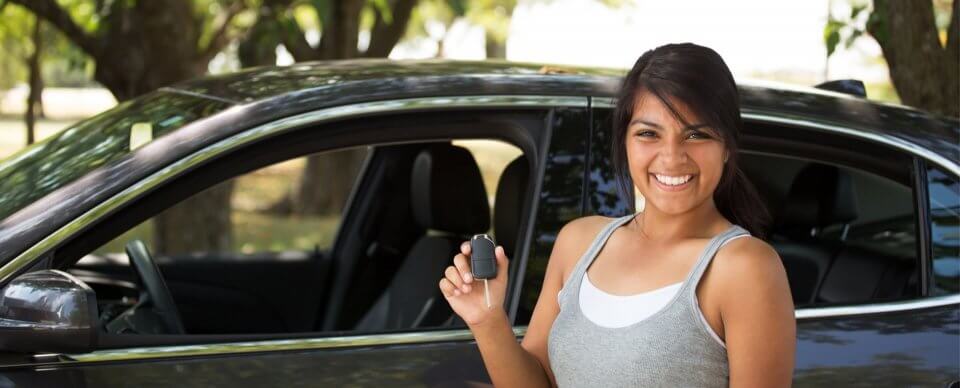
If you have been looking for car insurance for teen drivers, you’ve likely noticed the premiums are higher than they are for adults. Auto insurance companies determine premiums based on risk. Teenage drivers are considered riskier than mature drivers, so car insurance premiums are higher.
Insurance agencies view youth as a risk for various reasons. First, young adults don’t have a proven record or much experience. Teenagers are also more likely to text when driving and engage in other distracting behaviors. They are prone to reckless behavior, breaking laws and more likely to get into an accident. Collectively, this age group gets more traffic tickets and gets into more accidents than other age groups.
A note of caution: you typically cannot buy car insurance for someone who does not have a driver’s license (or a learner’s permit).
Rates tend to go down when drivers reach the age of 25 if they’ve maintained a good driving record, haven’t got caught breaking any laws and had no accidents. Until then, though, you have to find a way to insure your teenage driver. You can add your son or daughter to an existing policy or get a separate policy. Let’s go over some of the questions and answers surrounding finding affordable car insurance premiums for young drivers and see how to find a cheap policy for them.
Adding a Teen to an Existing Auto Policy
As a parent, there are benefits to adding your son or daughter to your existing policy. First, you can share vehicles. They will be covered if he or she drives your car, and you’ll be covered if you drive their vehicle.
Also, if they have a vehicle, you can get a multi-car discount. The multi-car discount should lower the premiums significantly.
Your teenager also might be eligible for a Good Student discount if added to a parent policy. Many providers only offer this discount when a youngster is added to a parent’s policy. This discount can also reduce the premiums for high-risk auto insurance.
Your child can also benefit from the perks you’ve earned on your auto insurance. These perks, such as the Good Driver discount, can lower the cost of the parent auto insurance policy.
There are also some drawbacks to consider. First, of course, your auto insurance premium will increase. This is true, even if you get various discounts.
Second, your teenage driver could cause you to lose some of the perks you currently have with car insurance companies. For instance, if you have a Good Driver discount, you could lose it if your child gets in an accident or worse, gets a DUI
Getting a Separate Policy for a New Teen Driver
You also have the option of getting a separate auto policy for your son or daughter. If you do this, your child won’t be able to benefit from your plan’s perks. Also, you won’t be eligible for a multi-car discount, and it’s unlikely your son or daughter will get a Good Student discount.
It can also be difficult for them to find a separate auto insurance policy. Many car insurance companies avoid selling these policies because of the risk. However, some companies do offer standalone policies for teens.
Even with the drawbacks, sometimes, it makes financial sense to get separate policies for new teen drivers. If you have multiple moving violations on your record, your premiums have already increased. Adding a teenage driver to your policy could cause your rates to increase to the point of making it impossible to pay. If adding them to your policy will be a financial burden, consider getting a separate policy.
How Much Does Car Insurance for Teen Drivers Cost?
It depends. The average cost of car insurance is $480 per month for a 16 year old, but just as with your policy, there are numerous factors that insurers use to come up with a premium. Let’s explore how an underwriter may come up with a number – given upfront that these driver policies always start out higher rates just due to the collective driving record of young adults. Stress to your young driver that their rates will only decrease if they keep a clean driving record. Tickets and accidents (especially those that result in a claim) will set the process back quite dramatically. Learning safe driving habits now will pay off in the long run.
The Age of the Driver
Obviously, rates at 16 are going to be substantially higher than those at 23. The average cost is $480 per month for a 16-year-old driver, while the rates at 23 average $250 monthly. There are several factors that go into this – chief among them is a brand new driver is inexperienced, has no driving history for insurers to look at and as a collective, they tend to get into more accidents.
Interestingly, Hawaii and Massachusetts do not allow age to be a factor when determining premiums. However, insurers can get around this by citing a lack of driving history when setting a premium.
The Gender of the Driver
It’s not fair, but young male teen drivers (and even older males) tend to pay more for their auto insurance than females. Insurance carriers tend to tip the scales in their favor when issuing policies and they base these decisions on collective driving behavior. Males tend to get in more accidents and drive more recklessly than females.
This trend to punish all male drivers due to the bad behavior of a few may be turning around. California, Hawaii, Massachusetts, Michigan, North Carolina and Pennsylvania do not allow gender to be a factor.
Car Make and Model
Just as with older drivers, the car’s make and model (but not the color) will influence auto insurance rates. A new driver with an expensive sports car is going to raise all sorts of red flags. Not only because car insurance companies might consider it a recipe for disaster, but because the costs for repairing such a car will be more costly.

How to Save Money on Car Insurance for Teen Drivers with Discounts
Most people would like to find a cheap car insurance premium. That may be especially true when it comes to youth. And just like us, they can save on some discounts, some of which are tailored specifically for them.
Keep Up the Grades for a Good Student Discount
Most carriers will offer a good grades discount to its young drivers. The discount will be applied if the student keeps up their grades – and sometimes their attendance – at high school and college. Your insurer will let you know what their standards are as far as how high of a GPA or percentage of attendance they need for the discount. Then, it’s just a matter of presenting your good grades records to keep the discount going.
Away at School Discount
This rate cut is based on someone who is a college student a certain distance from home and, most importantly, isn’t bringing a car with them to school. So, it boils down to a young driver who isn’t driving very much while they are a college student.
Defensive Driving Courses for Discounts
We could all use a refresher defensive driving course now and then and most insurance agencies will reward adult drivers and youth drivers who take the time to put this on their resume. Advocating for safe driving habits is a good idea.
Discounts Can Follow Tracking Devices
It’s relatively new compared to other methods and means our insurance companies use to keep an eye on our driving habits, but these tracking gadgets are installed on a vehicle to gather information about how fast we drive, how suddenly we accelerate and how much we stomp on the brakes, etc. If your insurer is happy with your driving pattern, there may be a discount in your future – same as your young driver.
Accident Forgiveness Just in Case
Accident forgiveness is a car insurance addition that may raise your premium, but it just might be a good idea. It works like this: your kid gets in an at-fault wreck. If you have accident forgiveness, this event won’t cause your auto insurance rates to increase. But be aware that it is usually only good for one accident!
The Full Coverage v Minimum Coverage Debate for Young Drivers
When we talk about minimum coverage, we are generally referring to the lowest rates of state-required liability insurance, as well as any other coverages required. This amount is going to be dependent on what state you live in, whether it’s a no-fault or at-fault state and other rate parameters set by the state. Liability refers to bodily injury and property damage coverage.
When we talk about full coverage insurance, we are generally referring to the state’s minimum requirements, plus the addition of comprehensive insurance and collision insurance. Most of the time, if a car is financed, a lender is going to want to protect their investment by requiring you to carry full coverage (and maybe other insurance products).
Motorists always have the option of increasing the dollar limits on the various components of their insurance package (and it is a good idea given what repair costs and hospital bills are these days).
Save Money on Auto Insurance for Teens
You can save money when insuring your teen. Enroll them in a defensive driving class and install anti-theft devices in your son or daughter’s vehicle. You also might save money by bundling insurance. Bundle your home, auto, and life insurance to reduce the cost of your child’s insurance.
Car insurance rates for youth can be expensive, but it’s money well spent. Choose the right insurance option for your family. Freeway Insurance can help you obtain car insurance at an affordable rate. We compare quotes from top insurance companies to ensure you get the best coverage at the lowest available rate. Request a teen car insurance quote online or over the phone today by calling (800) 777-5620.



